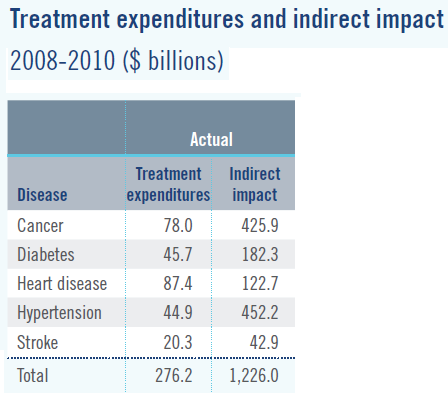Chronic Illness
Timothy Taylor summarizes:
 “According to the Centers for Disease Control and Prevention (CDC), chronic illness affects one of every two adults in the U.S., and they are responsible for 75 percent of health-care costs.”
“According to the Centers for Disease Control and Prevention (CDC), chronic illness affects one of every two adults in the U.S., and they are responsible for 75 percent of health-care costs.”
Their report estimates costs for five most common chronic diseases: cancer, diabetes, heart disease, hypertension, and stroke. One set of costs are treatment costs; a much bigger cost is the reduction in GDP when people are unable to work to their usual productivity, or at all. Of course, the measure here underestimates the full social cost because it does not seek to place a monetary value on the costs of death and suffering.
Source: Milken Institute report.


That is possible. This disease, however, is not that prevalent. Let us think it carefully.
I think the point of the study is that these diseases are all fairly prevalent. Heart disease is one of the top causes of death in America.
It’s true. As of 2013 one in every 4 deaths in America was attributable to heart disease, according to the CDC: http://www.cdc.gov/heartdisease/facts.htm
Most of these are strongly influenced by lifestyle factors. If citizens lived healthier lives, we would not have rampant chronic illness to the same extent.
The most interesting part of the statistics is the difference between expenditures and indirect impact. While hypertension ranks fourth on the amount of treatment expenditures, it has the largest differential of the five most common chronic diseases, standing at $407.3 billion!
Good point Jameson, but what does hypertension having the largest differential mean about the disease?
Good question Gregory. The Milken Institute’s piece has this to say about the indirect impact: “Indirect impact, as measured in terms of lost economic output (foregone GDP), was derived from the National Health Interview Survey (NHIS). The NHIS is a nationally representative survey of health conditions and employment. Indirect impact is the aggregate of absenteeism and presenteeism for both individuals and caregivers. Here, absenteeism is defined as the number of workdays missed due to illness, and presenteeism is defined as diminished productivity that occurs as a result of employees coming to work ill.” So, to answer your question, hypertension, with the largest differential, means that it has the largest effects on GDP than do any of the other four most common chronic illnesses.
I am a little lost on those huge numbers for ‘indirect impact.’
The Milken report did not seem to distinguish between sufferers under age 65 and those over 65.
Most sufferers from severe chronic illness are over 65 and in general
not working in the first place. Their ill health does not diminish productivity by one iota.
Even under age 65, many white collar jobs allow people to plug along perfectly well with hypertension and diabetes for years. America is no longer one big factory floor, when a man goes down with cancer and the assembly line has to stop.
In fact, I would go to the other extreme and ask whether good medical care is hurting the labor market. When I was growing up in the 1970’s, good jobs came open every day because men in their 50’s were dying from heart attacks and lung cancer. Today these men often survive, and the young suffer unemployment. I know this is rather sketchy and also morbid, but still worth considering.
“About 109 million Americans reported having at least one chronic disease in 2003 (the latest data available at the time)”
Why is 2003 the latest data we have? Shouldn’t we be tracking these sorts of things?
You’d think so. I mean, how are we supposed to know if things are getting better if we don’t keep track of important information like that?
Guess work? Magic 8 ball? Take your pick.
I was going to say that doctors might be too busy to report these numbers that often, but these numbers probably come from somewhere else. So I’m not sure.
“We projected rates of disease and associated costs under an optimistic scenario, assuming modest improvements in preventing and treating disease relative to a set of baseline or most likely assumptions. By 2023, we found, the United States could avoid 40 million cases, cut treatment costs $220 billion, and increase GDP $900 billion.”
Well that’s impressive.
And that’s just with modest improvements? Who knew?
I wonder how high those numbers would go if we partnered modest improvement in treatment with some way to get people healthier.